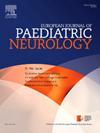Neurological manifestations in children with SARS-CoV-2 infection: a French multicentric cohort
IF 2.3
3区 医学
Q3 CLINICAL NEUROLOGY
引用次数: 0
Abstract
Objectives
This study aimed to assess neurological manifestations in French children hospitalized with SARS-CoV-2 infection. Secondary objectives were to evaluate the severity of these presentations and estimate the frequency of long-term neurological sequelae.
Methods
A multicenter observational study was conducted, including 71 children hospitalized for neurological manifestations of SARS-CoV-2 infection from January 2020 to March 2022.
Results
The median age was 8.7 years (range 4.2–13), with 49 % being girls. The most common neurological manifestations were encephalitis and meningoencephalitis (32 %). Brain imaging was abnormal in 68 % of cases. Half of the children required admission in intensive care unit (ICU). Nearly one-third of the children had neurological symptoms at the end of the follow-up, with cognitive difficulties being the most reported complaints. No significant associations were made between sex, age, neurological comorbidities, and the severity nor presence of sequelae. However, abnormal brain imaging was significantly associated with a higher risk of ICU stay (OR = 8.01 [95 % CI 2.37–27.1], p < 0.01) and with the presence of sequelae at discharge (OR = 4.65 [1.45–14.9], p = 0.011) and last follow-up (OR = 5.14 [1.40–18.9], p = 0.015).
Conclusion
Although rare, neurological manifestations in children with SARS-CoV-2 infection can be severe, with encephalitis as the most common clinical presentation. Abnormal brain imaging is a strong prognostic marker of acute severity and long-term neurological and cognitive sequelae. Objective assessment tools and longer follow-up are necessary to evaluate the long-term outcomes in these children.
SARS-CoV-2感染儿童的神经系统表现:法国多中心队列研究
目的评价法国住院儿童SARS-CoV-2感染的神经学表现。次要目的是评估这些症状的严重程度和估计长期神经系统后遗症的频率。方法对2020年1月至2022年3月因SARS-CoV-2感染神经系统症状住院的71例患儿进行多中心观察性研究。结果中位年龄为8.7岁(4.2 ~ 13岁),女孩占49%。最常见的神经学表现为脑炎和脑膜脑炎(32%)。68%的病例脑成像异常。半数儿童需要入住重症监护病房(ICU)。在随访结束时,近三分之一的儿童出现了神经系统症状,其中认知困难是报告最多的症状。性别、年龄、神经合并症和严重程度及是否存在后遗症之间没有明显的关联。然而,脑成像异常与ICU住院风险升高显著相关(OR = 8.01 [95% CI 2.37-27.1], p <;出院时存在后遗症(OR = 4.65 [1.45-14.9], p = 0.011)和末次随访时(OR = 5.14 [1.40-18.9], p = 0.015)。结论SARS-CoV-2感染患儿的神经系统表现虽然少见,但可能很严重,以脑炎为最常见的临床表现。异常脑成像是急性严重程度和长期神经和认知后遗症的预后标志。客观的评估工具和更长的随访是评估这些儿童长期预后的必要条件。
本文章由计算机程序翻译,如有差异,请以英文原文为准。
求助全文
约1分钟内获得全文
求助全文
来源期刊
CiteScore
6.30
自引率
3.20%
发文量
115
审稿时长
81 days
期刊介绍:
The European Journal of Paediatric Neurology is the Official Journal of the European Paediatric Neurology Society, successor to the long-established European Federation of Child Neurology Societies.
Under the guidance of a prestigious International editorial board, this multi-disciplinary journal publishes exciting clinical and experimental research in this rapidly expanding field. High quality papers written by leading experts encompass all the major diseases including epilepsy, movement disorders, neuromuscular disorders, neurodegenerative disorders and intellectual disability.
Other exciting highlights include articles on brain imaging and neonatal neurology, and the publication of regularly updated tables relating to the main groups of disorders.

 求助内容:
求助内容: 应助结果提醒方式:
应助结果提醒方式:


